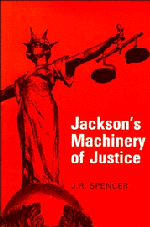Book contents
- Frontmatter
- Contents
- Acknowledgements
- List of figures
- List of tables
- Preface
- Preface to the first edition of ‘The Machinery of Justice in England’
- Abbreviations
- I Historical introduction
- II Civil jurisdiction
- 4 Civil law and criminal law
- 5 County courts
- 6 The High Court
- 7 The mode of trial
- 8 Complaints about the civil courts
- 9 The enforcement of judgments and orders
- 10 The Civil Division of the Court of Appeal and the House of Lords
- 11 The Judicial Committee of the Privy Council
- 12 Arbitration
- III Tribunals
- IV Criminal jurisdiction
- V The personnel of the law
- VI The European dimension
- VII The cost of the law
- VIII Law Reform
- Appendix A The Report of the Civil Justice Review
- Table of Cases cited
- Table of Statutes cited
- Table of Stationery Office publications cited
- Index
5 - County courts
Published online by Cambridge University Press: 10 January 2011
- Frontmatter
- Contents
- Acknowledgements
- List of figures
- List of tables
- Preface
- Preface to the first edition of ‘The Machinery of Justice in England’
- Abbreviations
- I Historical introduction
- II Civil jurisdiction
- 4 Civil law and criminal law
- 5 County courts
- 6 The High Court
- 7 The mode of trial
- 8 Complaints about the civil courts
- 9 The enforcement of judgments and orders
- 10 The Civil Division of the Court of Appeal and the House of Lords
- 11 The Judicial Committee of the Privy Council
- 12 Arbitration
- III Tribunals
- IV Criminal jurisdiction
- V The personnel of the law
- VI The European dimension
- VII The cost of the law
- VIII Law Reform
- Appendix A The Report of the Civil Justice Review
- Table of Cases cited
- Table of Statutes cited
- Table of Stationery Office publications cited
- Index
Summary
The ancient county court became a court for small cases and then virtually died away. When in 1849 Parliament set up a system of courts for small civil cases it was thought to be a good thing to continue with such a hallowed name, and the new courts were named county courts. It was an unfortunate choice of name because from their beginning down to this day they have nothing whatever to do with counties. The legislation establishing county courts was inspired by the rationalising spirit of Bentham and the organisation of these courts has been guided by convenience and not tradition. They are entirely creatures of statute. Their constitutional document is now the County Courts Act 1984.
County courts are distributed around the country on the same principle as post-offices: the idea is to make sure that in all parts of the country there is a county court within reasonable distance. To achieve this, the Lord Chancellor can alter the number and boundaries of county court districts and places where the courts are held. At one time there were over 400 county courts, but the advent of the motor-car has made it possible to concentrate the work in fewer centres, and in 1986 the number stood at 267. The volume of work varies as between courts.
- Type
- Chapter
- Information
- Jackson's Machinery of Justice , pp. 30 - 35Publisher: Cambridge University PressPrint publication year: 1989

